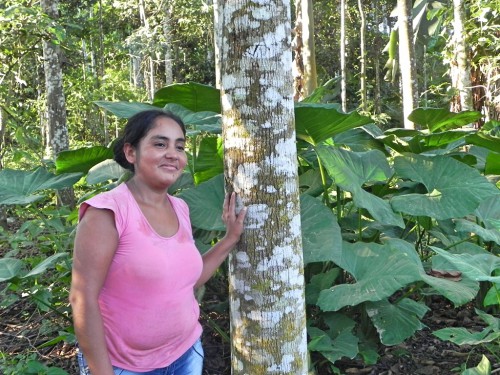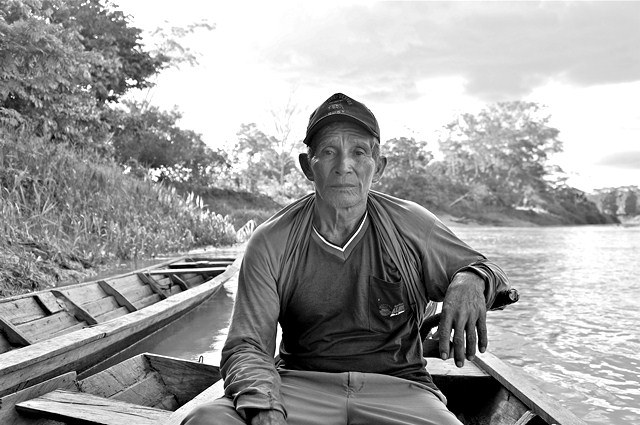Collectively, 20 farming households in a Peruvian Amazon village can easily produce 760 cubic meters of sawn lumber per year on their farms, or rather, agricultural fallows.
That’s 18 tractor-trailer trucks filled with small-dimension lumber going from the Amazon region to the nation’s capital, Lima, primarily for use in pre-fabricated houses for the city’s marginal populations.
The farmers mainly manage the fast-growing species Guazuma crinita, known locally as bolaina, which seeds itself into crop fields going to fallow, creating what often looks like a messy, dense timber plantation.
Farmers manage these forest stands in their complex production landscapes for both the environmental services they provide and timber production.
It’s not a plantation. Or is it?
How the timber produced in these systems should be regulated is a tough and interesting question.
It’s where science and public policy come together.
POLICIES FOR PLANTATIONS
In Peru, our Center for International Forestry Research (CIFOR) team, which includes Peter Cronkleton and Matias Pérez Ojeda del Arco, has been wrangling with policymakers on how the new Law no. 29736 takes account (or not) enduring and sustainable family forestry systems.
We set out to justify the inclusion of the fallow forestry system as a type of plantation
In an effort to relieve pressure on natural forests and balance the timber trade deficit, this new forest and wildlife law emphasizes plantation forestry.
The plantations registry program dramatically reduces the administrative and financial burdens of moving timber from a plantation, versus those from natural forest.
The guidelines for this new national plantation registry specifically recognize the “agroforestry system” as a type of forestry plantation system. Furthermore, the management of natural regeneration is considered an option for silvicultural practices.
Good, we say, because it is precisely the management of natural regeneration and coppice in fallows that smallholder farmers employ to produce timber.
Thus, we set out to justify the inclusion of the fallow forestry system as a type of plantation, so that Peru’s smallholder farmers can increase income from their sustainable forestry systems, and so that Peru can increase the production of legal timber.
The government’s fear, however, is that liberalizing, or deregulating farm forestry will provide even more opportunity to launder timber extracted without proper permits.
That fear is not unfounded, for there is a history and culture of illegal logging in Peru, but we think it can be managed.
But enduring institutional and cultural constraints in the forestry sector point to the need for the government to understand and seriously consider the realities on the ground in the forest sector: who are the actors, what their dynamics are, and what drives informality in the sector.
The question remains: are the regulatory and institutional frameworks in the Peruvian forestry sector supportive of on-farm timber production, in any of its forms?
The forest policy regulations, to be published in the second half of 2015, may be a step in this direction.
HAIL FALLOW, WELL MET
But back to bolaina.
Soon after the decree was published in October last year, Ernesto Rosado, from the Ucayali regional forest office, contacted CIFOR requesting help.
Applications to register plantations had begun to trickle into the Ucayali regional forest office and Rasado, the forest officer in charge of reviewing applications, noticed that the first submissions were, surprisingly, for “agroforestry type” plantations, or rather, fallow forestry.
Many indicated a volume of bolaina per hectare that defied logic.
But…. maybe this is not so surprising. If there is any class of actors who are more flexible and adaptable than smallholder farmers, it is loggers. And they were perhaps already looking forward to using this new mechanism to launder timber that was accessed outside of permitted areas.
Rosado asked CIFOR for assistance in defining the upper range of volume of bolaina that can reasonably be produced in a hectare of fallow.
What about the realities of policy making?
Based on data from decades of our research on fallow forestry, we produced a memo addressing his question, also referencing experimental studies on plantations of native species in Ucayali from the World Agroforestry Center (ICRAF).
Our estimate reported a conservative upper range of volume of 38.5 cubic meters of sawn wood of bolaina from one hectare of six-year-old fallow forest, which is the lower age limit of harvest in this region.
THE TROUBLE WITH REALITY
Through research we have been gathering evidence of the multiple realities of smallholder forestry. Those policy makers need to get out to the field more, we insisted, to understand these realities.
Reality.
We believed that it was our point of departure.
Sociologist colleague Donna Huse took issue with our position, however.
“What about the realities of policy making?” she asked.
“The political context, the national trade balance, the institutional structures; are they not also realities to be reckoned with?”
Whose reality counts?
All the actors along the value chain, even the policy makers, are struggling in their own reality to operate in an uncertain and ever-changing market, political, and biophysical environment.
A culture of exploitation by capitalized logging teams of anyone who has access to timber keeps informal channels active, and confounds state efforts to monitor and enforce forest regulations.
The wholesale vilification of smallholder farmers as the primary cause of deforestation in the Peruvian Amazon leaves state actors reluctant to open doors for smallholder forestry.
Without understanding these realities, and without strong institutional support directly to farmers and other actors on the value chain, the plantation registry stands to become yet another mechanism for capitalized actors to exploit the hard work and years of patience of Amazonian farmers who integrate forestry activities in their farm production mosaics.
The question remains whether this iteration of the forest policy, and its implementers, can accommodate the realities of smallholder forestry. Is formalizing the informal the best way forward?
FROM RESEARCH TO POLICY
Ernesto Rosado, the Ucayali forest officer, later reflected that very few applications would likely be coming in to his office without the inclusion of the agroforestry system as a category of plantation.
It is our hope that the recognition of family forestry systems in the national plantation forestry registry program, a recommendation that our CIFOR team made in 2014 together with colleagues at ICRAF, will result in the increased production of fast growing timber on farms, improvements in rural farm income, and the endurance of sustainable rural farming and forestry practices.
Stay tuned.
Robin R Sears is a consultant with CIFOR in Latin America. Please contact her at r.sears@cgiar.org
We want you to share Forests News content, which is licensed under Creative Commons Attribution-NonCommercial-ShareAlike 4.0 International (CC BY-NC-SA 4.0). This means you are free to redistribute our material for non-commercial purposes. All we ask is that you give Forests News appropriate credit and link to the original Forests News content, indicate if changes were made, and distribute your contributions under the same Creative Commons license. You must notify Forests News if you repost, reprint or reuse our materials by contacting forestsnews@cifor-icraf.org.

